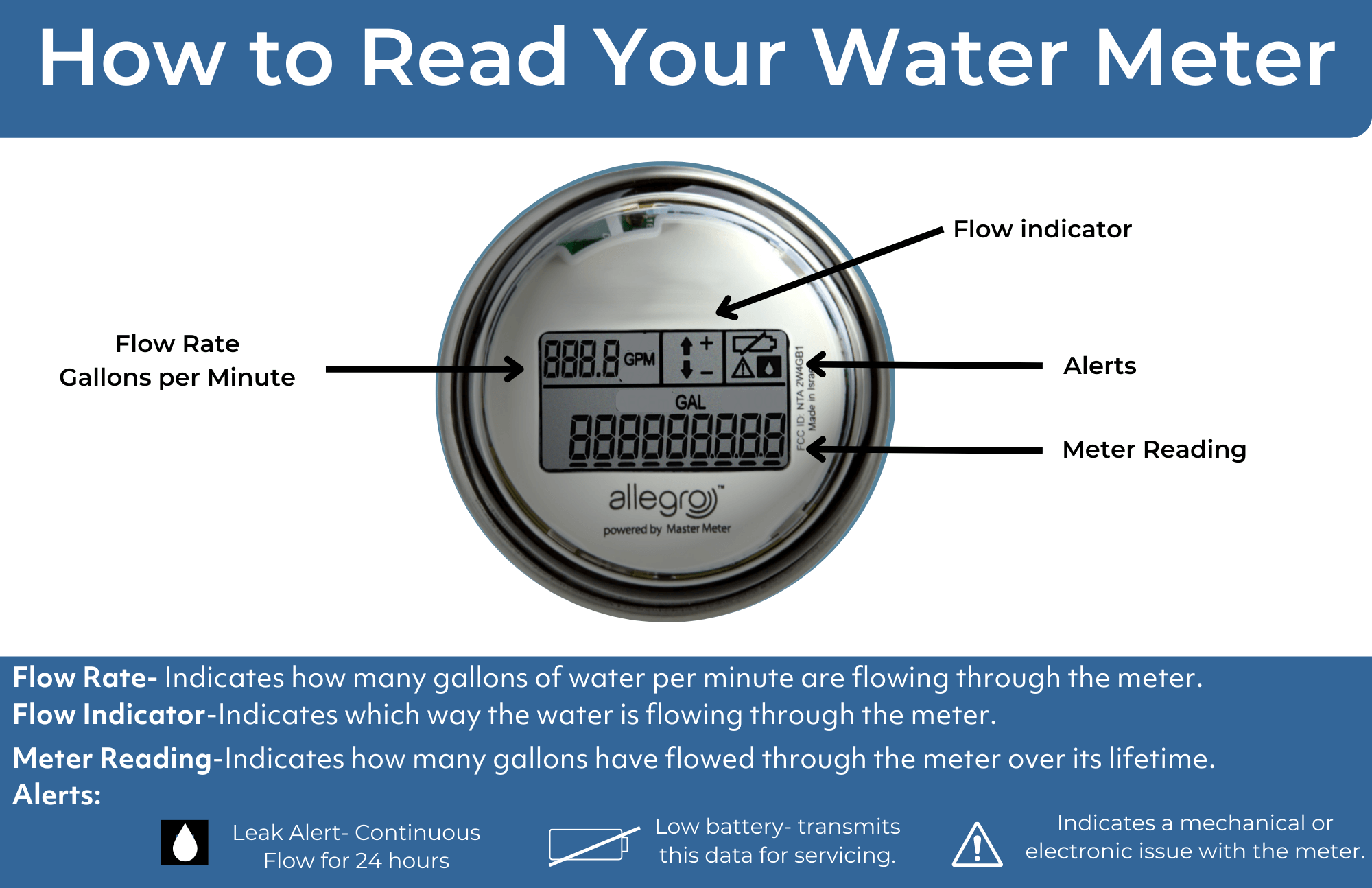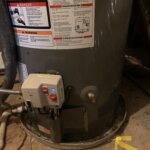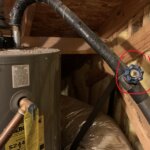The how-to’s and what-if’s of your home’s water and wastewater (sewer) utilities. Whether you’re a renter, homeowner, or business owner, these tips can save you money.
For Water or Wastewater Emergencies, call 512-218-5555, 24 hours a day, 7 days a week.
How To's and What If's
ONLINE
View your water usage hourly, daily, and monthly on the Customer Portal. (You may need to disable the pop-up blocker on your browser to view your consumption.)
Note: There is a 4-hour latency window for viewing consumption. For example, if you log into your portal at 5 p.m., you will see your consumption data up to 1 p.m. for that day.
Alerts: Stay informed about continuous usage and set thresholds alerts ensuring you’re in control of your water consumption.
If you have an account, simply log in using your credentials. If you’re new to the portal, access our video tutorial and step-by-step guide (PDF) to help you create an account.
WATER METER
- Open the meter box’s lid to read your water meter. Record the numbers along the bottom of the meter face. (This is like a car’s odometer.)
- After 20 minutes, repeat the first step.
- Subtract the first water meter reading from the second to determine the consumption.
Contact Utility Billing at 512-218-5460 if you have questions regarding your water bill.
Slight discoloration in your water can occur from time to time. Your water is safe. The City’s water quality information is provided in the annual Consumer Confidence Report.
Here’s what the discoloration may mean:
- Black particles – degraded rubber gaskets, o-rings, or meter washers. Check faucet head and replace o-ring.
- Brown water – possibly caused by nearby construction, hydrant flushing, or manganese in the water supply. Call 512-218-5555 to request the City to flush the hydrants.
- Cloudy or Milky water – air bubbles from air in the pipes or a temperature change.
- Yellow water – manganese or resin from a water softener.
The meter box is usually located near the curb with a black plastic, rectangular lid; between your and a neighbor’s home. There are often two meters inside, yours and your neighbors, yours is the one closest to your property. If you live on a corner lot, the meter box may be around the corner, closer to the home behind yours, but still along the street.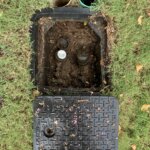
In this picture, the the meter box’s lid is open to show the two meters inside.
If you see water coming out of the water meter, or in the meter box, call 512-218-5555 to have the City come check the meter for a leak.
Verify the status of your account with Utility Billing. If you haven’t paid your bill, your water may be shut off. City staff would have left a doorhanger on your front door that says you have an unpaid bill.
If your account is current, your water may be off due to any of the following occurring in or around your neighborhood:
- Water main break*
- Construction*
- Blockage in water softener line
- Frozen pipes
- Private water leak and the meter was turned off to prevent damage and water waste
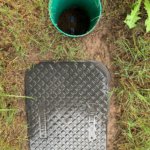 You can shut your water off at the meter by turning the homeowner’s cutoff valve located just above your meter box. It’s a round tube with a metal or green plastic lid.
You can shut your water off at the meter by turning the homeowner’s cutoff valve located just above your meter box. It’s a round tube with a metal or green plastic lid.
In the picture, the water meter has the black lid, the homeowner cutoff “box” is open.
If you haven’t seen this box before, it may be buried under the grass or dirt or you may not have one. A plumber can be contacted to install a homeowner cutoff valve for you.
You can also call 512-218-5555 and a City crewmember may be able to assist locating the cutoff valve at no cost to you.
The average water hardness in Round Rock is 221 mg/L or approximately 12.9 grains per gallon. To learn more, visit Water Quality.
To reduce water pressure, PRV’s should be set to 75 psi (pounds per square inch) or lower. Irrigation systems do not run effectively with high water pressure, a lot of water is lost due to misting. Ideal water pressure for irrigation is between 35 – 50 psi.
The minimum water pressure allowed by the state is 35 psi. The City’s goal is to achieve a minimum of 50 psi at every meter.
If you have low water pressure, or it’s noticeably decreased over time, the PRV could be failing. As they age, they begin to close, thus reducing water pressure. A licensed plumber can repair or replace the PRV.
Water Leaks
Some water leaks are easy to spot – like water dripping from the water heater, or a toilet constantly running; but there are many hidden leaks that you may not be aware of.
Leaks can be anywhere there is a water pipe or an appliance that uses water. In the event the leak is on the main water line between the water meter and your house, it may not be seen.
Our area is full of limestone rock, which is very porous. Water can easily flow through the ground and rock. There may not be an obvious pooling of water on the yard. There may be greener or taller grass in the area.
The first place to check if you have a leak is at your water meter. (See “Locate the Water Meter” above for help finding your meter.)
- Make sure no water is running inside or outside (washers are off, etc.).
- Go outside to your meter box and open the lid. You may need a long screwdriver to help pop it open.
- Watch the meter for several minutes to see if there’s movement.
- If any numbers change or an arrow symbol appears in the top middle section (see above “how to read your water meter”), water is flowing through the meter. Often, toilets leak slowly, then fill up suddenly, so watch the meter for several minutes.
- If you have continuous water flow for over 24 hours, a triangle shape with an exclamation point will appear in the top right corner.
Sign up to receive continuous flow or leak notifications from our customer water portal. Our metering system will send you a text, an email, or both if water is detected running for 24-hours through your meter.
You can enter in more than one email address and more than one phone number.
Find the customer portal information and how to sign up for the alerts on this billing webpage and look under the “Consumption Portal FAQs” section.
Did you receive a continuous water usage alert? If so, don’t panic. Start by checking your consumption reports on the customer portal, which will show your hourly, daily, weekly, or monthly water use to help you spot trends.
Focus on your hourly usage for the last 24 hours, paying attention to how many gallons are used each hour. This will give you a clearer picture of what’s happening.
In the picture below, the water use is nearly 300 gallons each hour of the day! The different colors indicate which water rate tier the amount of water will cost.
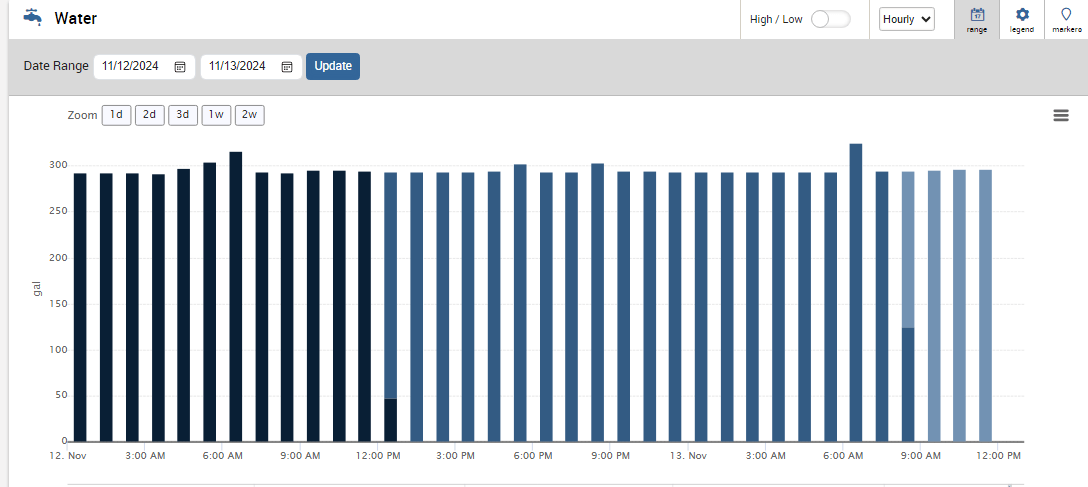
The metering software detects continuous water flow over 24 hours, meaning water was used every hour in that period. This doesn’t always mean you have a leak—it could be normal usage from things like an ice maker, water softener, or occasional toilet flush. However, it could also be from a dripping faucet or leaky fixture.
If you notice high water usage, check for dripping faucets, faulty fixtures, or potential leaks.
Water waste from leaks can range from minimal to significant, depending on the severity.
Where to Check for Leaks
The video below walks you through a typical house to identify places a water leak could be happening and how to fix it.
Flappers that are not sealing are the number one source of leaks inside the house. Use dye tablets or food coloring to see if the flapper isn’t sealing properly.
Dye tablets are available free of charge at the Utility Billing office or by request. Email the water conservation team.
The video below shows how to check a toilet for leaks.
- Drop a dye tablet or several drops of food coloring into the toilet’s tank (back part) and wait. Do not flush.
- If after 10 minutes you see coloring in the toilet bowl, you have a leaky flapper.
- Make sure you know the brand and model number of the toilet when purchasing a new flapper. (This can be found inside the toilet tank.)
- If the toilet was installed before 2006, replacing it with a newer model may be better. Not only are newer models more water efficient, the City’s Better Bathroom Rebate makes them easier to buy!
By state plumbing code, a pan should be under the water heater to help protect the house from water damage from a leaking water heater.
If water is in the pan, there is a leak in the water heater.
Turn the water off to the water heater to prevent continuous water flow. The knob could look like a hose spigot or a butterfly valve and would be located on one of the pipes leading into the water heater. In the picture, see the knob circled in red.
Listen for signs of recharging of the unit. Typically, they only recharge at night; if you hear it during the day or constantly, you should have a service company check it.
Water dripping or constantly running from the bathroom or kitchen faucets, the bathtub, or outdoor hose bibs are typically easy fixes. Free plumbers tape is available at the Utility Billing office or by requesting a leak kit.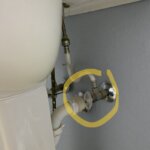
To stop the dripping until it can be fixed, turn off the knobs under the sink. It could be in a cabinet under the sink, or if a pedestal sink, like the one pictured, the knobs are visible on the wall. There is one knob for hot and one for cold water.
Some leaky showerheads can be fixed by making sure they’re screwed in tight and using plumber’s or Teflon tape to secure it.
Plumber’s tape is available free at the Utility Billing Office or by request. Email the water conservation team.
For more complicated valve leaks in showers, contact a licensed plumber.
Run each zone of the system manually to visually inspect each area. Sometimes a line break is easy to spot, as water will be pooling into the yard, street or sidewalk.
Often leaks aren’t visible thanks to the rocky, karst limestone area we live in. The water flows down through the rock and we don’t see a pool of water in the yard.
You’ll need to look for signs of low water pressure, such as sprinkler heads not popping up.
If a leak is found, you can turn the water off to the irrigation system by turning off the backflow prevention device or the master valve. See how to, in the video below.
If your water feature — like a swimming pool, hot tub, pond, or spa–has an automatic fill valve, it may be continuously running, much like a toilet.
- Locate the fill valve in the ground, often around the pool area. Open the lid. It may look similar to the picture here.
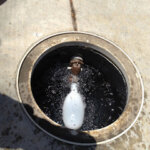
2. Is it making a hissing noise? If so, that could be the water continuously running.
3. Turn the water off to the fill valve. This may be located near the pool equipment, close to the house.
4. Go check the meter to see if the continuous flow has stopped.
Contact Us | ||
| Billing Questions | 512-218-5460 | |
| General Information | 512-218-5555 | |
| Maintenance/Repairs | 512-218-5555 | |
| Rebate Programs | 512-671-2872 | waterconservation@roundrocktexas.gov |
| Water Treatment Plant Tours | 512-218-6699 | Tour Request Form |

